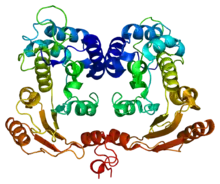ADP-ribosyle cyclase
L'ADP-ribosyle cyclase, souvent écrite ADP-ribosyl cyclase par anglicisme, est une glycoside hydrolase qui catalyse les réactions :

| N° EC | EC |
|---|---|
| N° CAS |
| IUBMB | Entrée IUBMB |
|---|---|
| IntEnz | Vue IntEnz |
| BRENDA | Entrée BRENDA |
| KEGG | Entrée KEGG |
| MetaCyc | Voie métabolique |
| PRIAM | Profil |
| PDB | RCSB PDB PDBe PDBj PDBsum |
| GO | AmiGO / EGO |
Cette enzyme catalyse à la fois la formation et l'hydrolyse de l'ADP-ribose cyclique, un second messager intervenant notamment dans le métabolisme du calcium, susceptible de mobiliser les réserves intracellulaires de cations Ca2+ et de favoriser l'entrée de ces ions dans la cellule pour réguler une grande variété de processus physiologiques.
L'ADP-ribosyle cyclase est connue sous une multitude de noms d'usage, souvent ambigus et parfois trompeurs, notamment NAD+ nucléosidase, NADase (ambigu), NAD hydrolase (ambigu), NAD glycohydrolase (trompeur), CD38[2],[3],[4],[5],[6] (nom d'un gène), ou encore BST1[1] (nom d'un gène). Elle ne doit cependant pas être confondue avec la NAD+ glycohydrolase stricto sensu, qui correspond à l'activité enzymatique EC , globalement semblable mais néanmoins distincte de celle de l'ADP-ribosyle cyclase par le fait qu'elle ne forme pas d'ADP-ribose cyclique.
De plus, l'activité enzymatique EC est parfois portée par des protéines multifonctionnelles, ce qui peut prêter à confusion. Ainsi, une ADP-ribosyle cyclase est également capable de catalyser une réaction semblable avec le NADP+ comme substrat, ce qui correspond à l'activité enzymatique 2’-phospho-ADP-ribosyle cyclase (EC ).
Notes et références
- (en) Sumie Yamamoto-Katayama, Mariko Ariyoshi, Katsuhiko Ishihara, Toshio Hirano, Hisato Jingami et Kosuke Morikawa, « Crystallographic studies on human BST-1/CD157 with ADP-ribosyl cyclase and NAD glycohydrolase activities », Journal of Molecular Biology, vol. 316, no 3, , p. 711-723 (PMID 11866528, DOI 10.1006/jmbi.2001.5386, lire en ligne)
- (en) M. Howard, J. C. Grimaldi, J. F. Bazan, F. E. Lund, L. Santos-Argumedo, R. M. Parkhouse, T. F. Walseth et H. C. Lee, « Formation and hydrolysis of cyclic ADP-ribose catalyzed by lymphocyte antigen CD38 », Science, vol. 262, no 5136, , p. 1056-1059 (PMID 8235624, DOI 10.1126/science.8235624, Bibcode 1993Sci...262.1056H, lire en ligne)
- (en) S. Takasawa, A. Tohgo, N. Noguchi, T. Koguma, K. Nata, T. Sugimoto, H. Yonekura et H. Okamoto, « Synthesis and hydrolysis of cyclic ADP-ribose by human leukocyte antigen CD38 and inhibition of the hydrolysis by ATP », The Journal of Biological Chemistry, vol. 268, no 35, , p. 26052-26054 (PMID 8253715, lire en ligne)
- (en) A. Tohgo, S. Takasawa, N. Noguchi, T. Koguma, K. Nata, T. Sugimoto, Y. Furuya, H. Yonekura et H. Okamoto, « Essential cysteine residues for cyclic ADP-ribose synthesis and hydrolysis by CD38 », The Journal of Biological Chemistry, vol. 269, no 46, , p. 28555-28557 (PMID 7961800, lire en ligne)
- (en) K. B. Fryxell, K. Odonoghue, R. M. Graeff, H. C. Lee et W.D. Branton, « Functional Expression of Soluble Forms of Human CD38 in Escherichia coli and Pichia pastoris », Protein Expression and Purification, vol. 6, no 3, , p. 329-336 (PMID 7663169, DOI 10.1006/prep.1995.1043, lire en ligne)
- (en) « Crystal structure of human CD38 extracellular domain », Structure, vol. 13, no 9, , p. 1331-1339 (PMID 16154090, DOI 10.1016/j.str.2005.05.012, lire en ligne)
- Portail de la biochimie